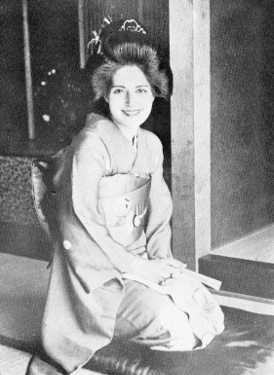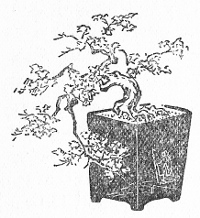
| Adrienne Moore (fl. 1937-1942) wrote in the Preface to her 1939 book Interviewing Japan, "This volume endeavors to suggest the old in the new and the new in the old in present day Japan. The [30] articles [or chapters], most of which appeared in part or entirety in the Japan Advertiser and one of two in the Tourist Magazine, Asahigraph and Los Angeles Times during the past two years, have been chosen with this idea in view. Furthermore, they have been kept in the original interview and conversational form in order that the human element might not be lost." Apparently because of the war, this Columbia University grad then travelled to India where she produced the book Rammohun Roy and America (Calcutta: Sadharan Brahmo Samaj, 1942). 1 |

Interviewing Japan (1939):

Bonsai, or the art of dwarfing trees, seems to have originated in the Ashikaga era (1333-1593) in Kyoto and remained a strictly private and guarded art until after the Meiji Restoration in 1868. In fact, during the Tokugawa era when horticulturists, both amateur and professional, had more interest in developing new species than [167] working miracles with seedlings, the art nearly died out[sic]. In Meiji 8 (1876) the first bonsai shop, the Saikaen in Tokyo near Tameike [to the southwest of the Imperial castle], was founded. Since then, bonsai have tended to become a fad. The main limitation is the cost, for 10,000 yen is not a fantastic sum to pay for a single bonsai. I found Mr. Seiji Uchiyama, proprietor of the Saikaen, puttering among his trees. At the moment of my entry Mr. Uchiyama was tending an imitation forest with maternal care. "There are many secrets to bonsai success but the most important is patience," said Mr. Uchiyama as he put down his watering can and gently patted the soil of his little charge. "Even then you must expect half of your trees to die and to wait ten or twenty years before you get any real results." There are ten varieties of bonsai, classified according to form rather than to the species of plant or tree, Mr. Uchiyama pointed out. The simpliest [sic] form is the single, miniature tree trunk which is straight. Add to this the complication of a slant and a tree growing on the side of a hill is suggested to the viewer. A third style is a tree with a curving trunk which is supposed to conjure up a picture of a tree distorted by sea winds. Another style is the overhanging plant which creates the illusion of a tree hanging over a cliff. Bonsai with two or more trunks make up other classifications. There is, for instance, the single root which forms more than two trunks from the base and there is the five-trunk bonsai with all trunks coming from one root. A seventh form creates [168] the illusion of several separate trunks, though here also there is only one root. Other styles are more exotic. For instance, there is the lying-down trunk whose branches go up like separate trees, the bonsai with two or more different kinds of trunks in one pot, and the fantastic bonsai wherein a lonely tree clasps an enormous rock with its roots. "The whole purpose of the bonsai is to create the illusion of a scene or forest. In fact, the ideal is to suggest all nature through a single tree," said the expert as he pointed out with delight a decrepit-looking specimen with its trunk lying parallel to the soil. This miniature of antiquity he had recently picked up at an auction sale. It was about a foot high, was several hundred years old, and worth about 1000 yen. Though the final aim may be aesthetic, the years of work behind the production of a worthy bonsai are sheer practicality. First, a plan must be made and the tender branches wired to form the picture desired. These wires corset the trees most of the time except when they are on exhibition. Moreover, they must be continually watched and changed before they begin to press on or cut the bark as the plant grows. The actual problem of dwarfing begins with the roots which are cut so that the tree is undernourished. To assist this, the tree must be always moist and yet only a third of the normal amount of water is administered. The soil is also carefully tended. Usually the tree is replanted once a year either at the time of the spring or autumn equinox. This soil change is tended to only [169] once in several years in the case of pine trees. The shoots are also picked in order to stunt growth. In the Nagoya district, opium is placed on the top soil to promote dwarfing [sic] but this is a delicate process for if the drug comes into direct contact with a major root or too much is used, the plant is apt to die. No tree is even worthy of the name of bonsai unless it is ten years old in the estimation of Mr. Uchiyama. Then, if all has gone well, his critical eye judges the plant for symmetry and the relative proportion of trunk to root. The roots must not look too big for the trunk nor the trunk for the roots. They must appear to really belong to each other even though the roots have been cut time and time again. Branches and leaves are of secondary importance. If perfection has been achieved, Mr. Uchiyama can imagine he is fording a stream in a valley or walking in a forest or some other scene as he looks at a newly born bonsai. Actually, age is not a matter of supreme importance. It is the appearance of maturity which counts. This can be faked. Mr. Uchiyama explained that plums are especially amenable to this hurry-up process. New branches are added to old rotten ones by making a hole in the old bough and inserting dirt and the new branch. Grafting is also resorted to. Or a fresh new plum branch can be made to look as old as Methusaleh in a year's time by having its trunk cut in half. Thereafter only the outer bark is watered and kept alive so that the heart of the bough rots. In fact, Mr. Uchiyama guarantees to revive the most rotten of lichen-covered boughs [170] provided the bark is still alive. Due to such faking, Japan's many bonsai stores are able to furnish fair looking plants to the New Year's rush trade for as little as fifteen yen each. An average collector of modest means usually gets more patiently cared for trees at from 100 to 500 yen. "Of course I realize the average person cannot afford such bonsai. Moreover bonsai have to be expertly care for. So I have evolved a plan for renting out my trees for two weeks at a time. My men go every few days to the foster-homes to water the plants and look after them. I don't trust them to amateurs. It's too hard to condition them after they have been abused and you just can't take a chance when a tree is several hundred years old. Anyway, I get attached to each of my fine trees. They have personalities of their own," said Mr. Uchiyama paternally as he told of the troupe of tree nursemaids he sends out to call on his little trees in their various adopted homes. This nursemaid service also extends to private collections, for Mr. Uchiyama advises that all owners of high class bonsai call in an expert to inspect their trees at least three times a month. Bonsai fashions come and go. A bonsai fancier might plant only pines and then find out ten years later that cherry trees are all the rage. "It isn't quite as bad as that, however," reassured Mr. Uchiyama, "for a really beautiful bonsai, like a beautiful painting, never goes out of date." It is the cheaper trees which change in style. Pines are always good but fruit-bearing trees were once all the rage. This year miniature forests of mixed trees, [171] particularly cryptomeria [Cryptomeria japonica, sugi] and keyaki [Zelkova serrata, Japanese grey-bark elm], are in style. These forests are the furthest away from the original plan of a bonsai which the art has yet reached, for, claims Mr. Uchiyama, the idea started as a sort of permanent flower arrangement. Bonsai collecting has always been the fad of the wealthy, for few can afford such collections as Count Miyoshi's which is valued at 100,000 yen, or Mr. Keikichi Tanomogi's. Count Sakai has a group of tiny plum trees less than four inches high but valued at about seventy yen each. Some of these collectors own rare toshio [Juniperus rigida, needle juniper] which have been dwarfed by nature, they are so rare, however, that they offer little competition to man-made bonsai. Such toshio, explained Mr. Uchiyama, come mainly from Sanshu near Shizuoka where they grow at high altitudes on almost soilless, shady cliffs. These pines are twisted and distorted by the wind so that their reputation for beauty is justly deserved. Some of them have been sold for as much as 15,000 yen. But Mr. Uchiyama prefers to create his own bonsai. He is proud of his products and admits that they often send him off into day dreams about woods and cliffs above the sea. He works with trees as a painter does with colors of his palate and his products are often just as startingly beautiful. "I hate to sell any of them," he said, fingering the budding bough of a delicate kaido [Malus spp., crab apple] tree whose limbs have the rhythmic poise of a ballet dancer. 2 |
|
1 Moore, Adrienne Interviewing
Japan (Tokyo: The Hokuseido Press; 1939), Preface, pg. v, dated July 4, 1939. Portrait from
Frontispiece with the caption "The author in her home in Japanese dress and shimada." 2 Moore, pp. 166-171. From the
chapter "Tree Magic". |